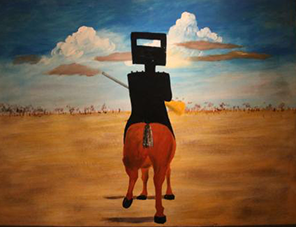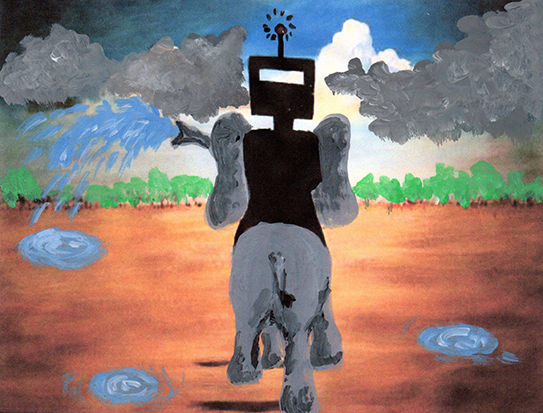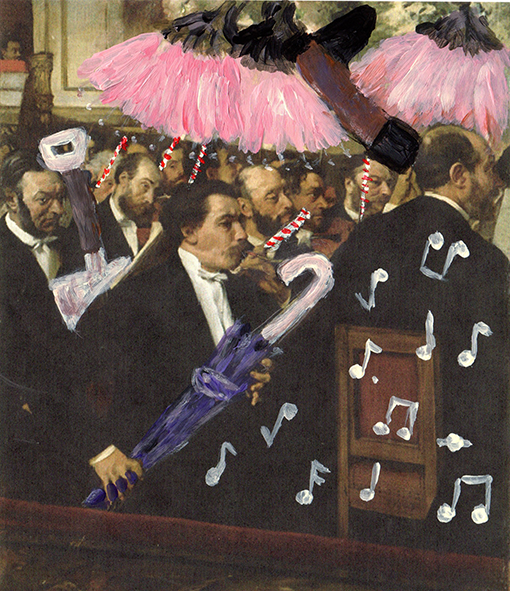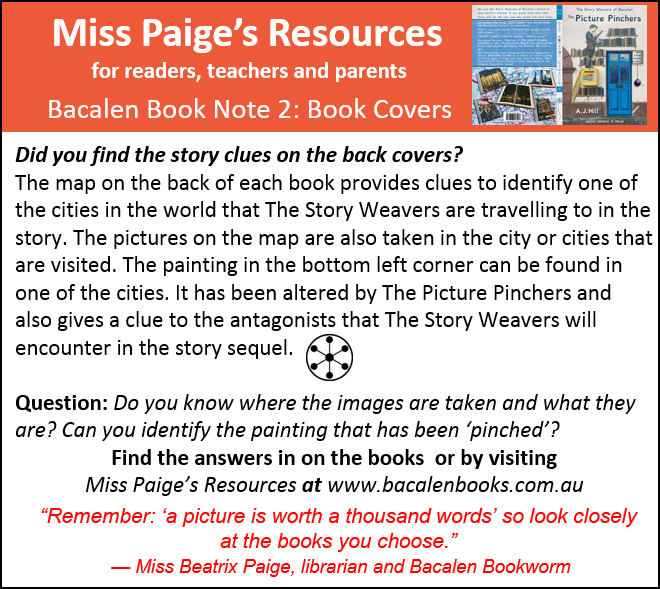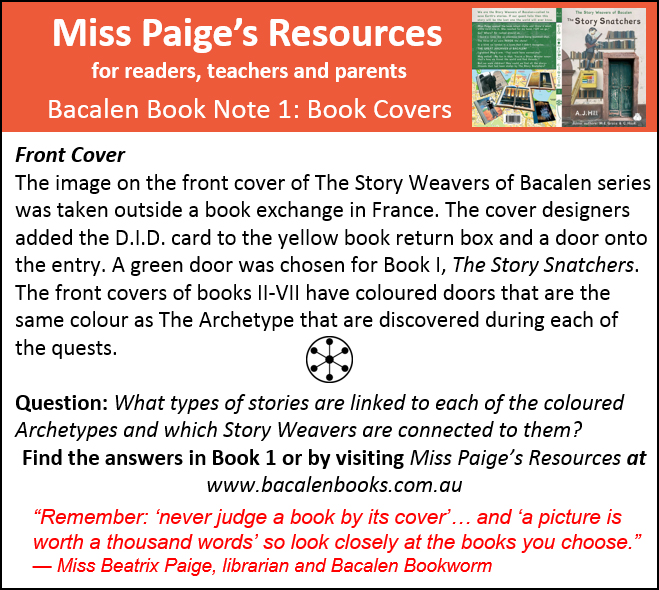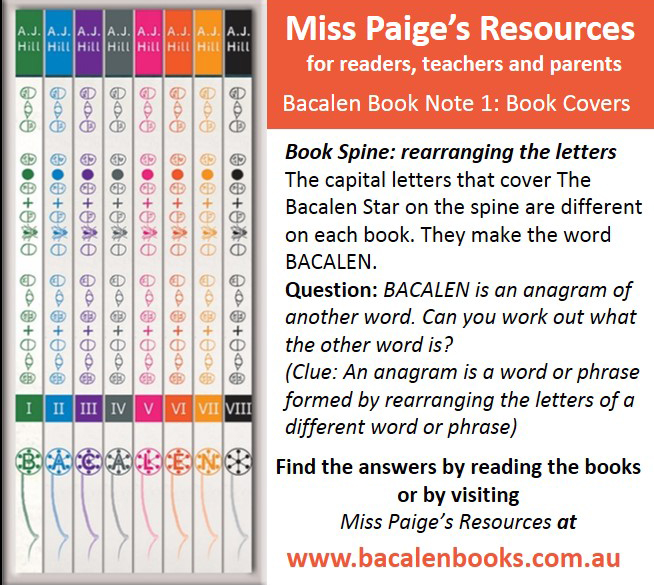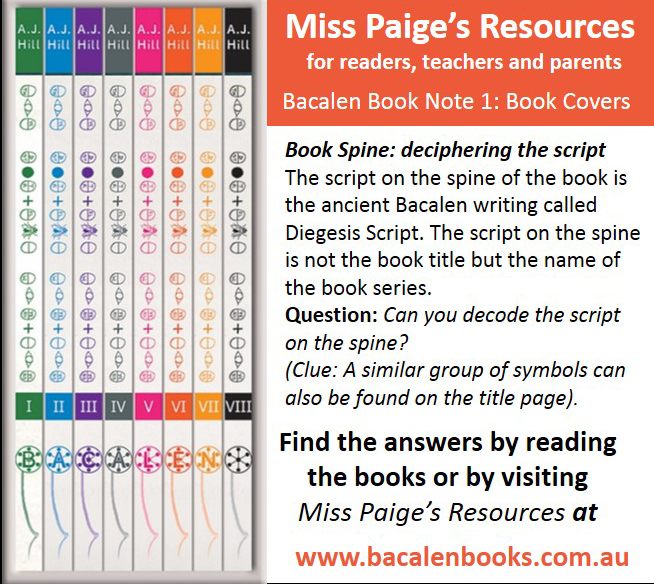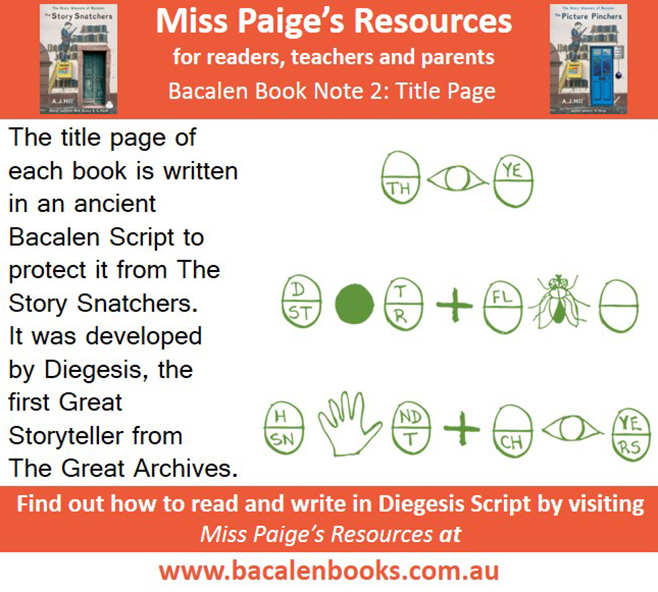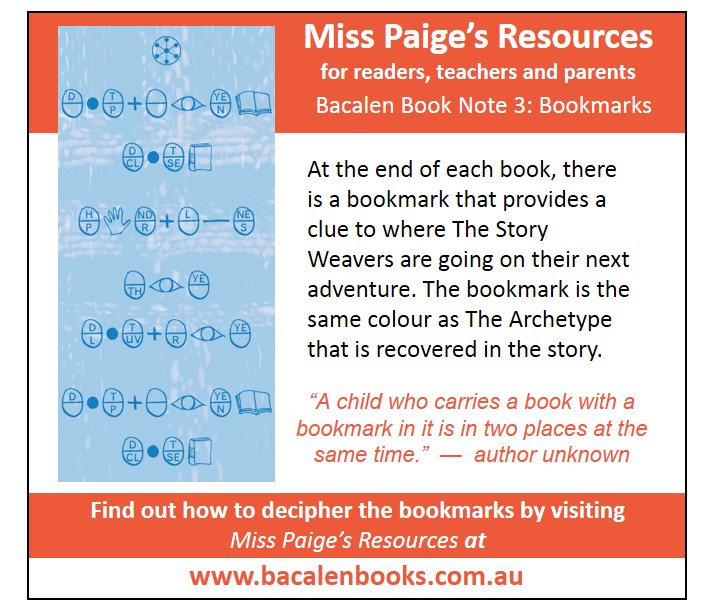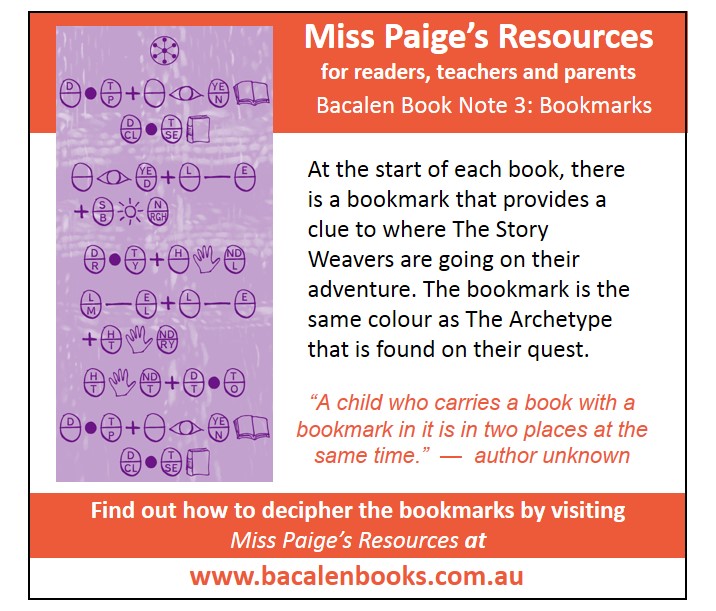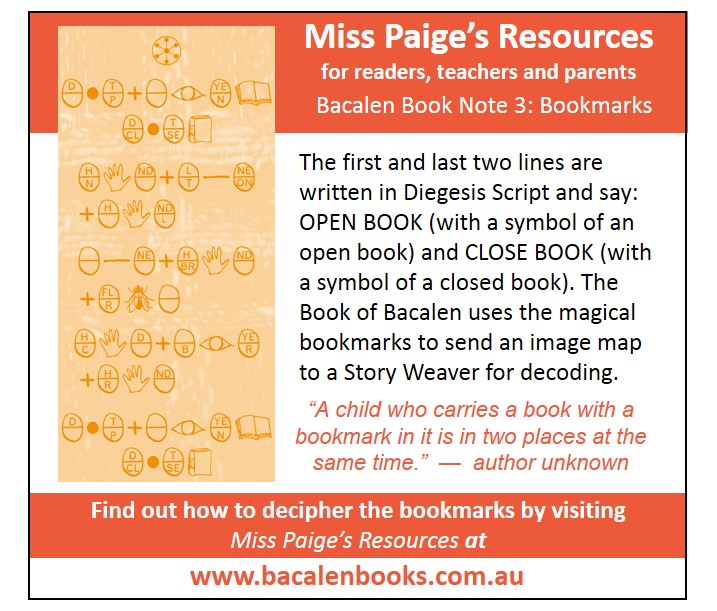Miss Paige’s Resources
THE BOOK NOTES 1–9 BELOW CAN BE EXTREMELY USEFUL AS TEACHING RESOURCES AND FOR LEARNING MORE ABOUT HOW AND WHY THESE STORIES WERE CREATED.
This information about clues on the book covers, bookmark codes, Diegesis script, Bacalen orbs, collective nouns and acronyms has been compiled by Miss Beatrix Paige who is an extraordinary librarian with a secret identity (Bacalen Bookworms are often librarians!). These book notes are for all imaginative children and readers (including teachers and parents) to explore, question and enjoy.
(Answers and Additional Questions to Book Notes 1–9 can be found at the end of this section)
You can READ ALL the chapters from The Story Weavers of Bacalen: The Story Snatchers (Book 1)
We want to encourage and support readers and particularly children with Irlen Syndrome and dyslexia.
The Story Weaver’s first adventure, The Story Snatchers, is currently out of print. However the chapters from The Story Snatchers are available to readers below. Please read the story, use the resources from our Bacalen Archives’ librarian, Miss Paige, and travel the world with our Irlen heroes, The Story Weavers of Bacalen.
Click here to read Chapter 1 How can books just vanish?(posted April 6, 2020)
Click here to read Chapter 2 What sort of gift is this? (posted April 14, 2020)
Click here to read Chapter 3 Who knows the book’s real story? (posted April 20, 2020)
Click here to read Chapter 4 Where are the stories going? (posted April 27, 2020)
Click here to read Chapter 5 Why is a Storyteller important? (posted May 4, 2020)
Click here to read Chapter 6 Who are the Story Snatchers? (posted May 11, 2020)
Click here to read Chapter 7 When are Story Weavers most powerful? (posted May 18, 2020)
Click here to read Chapter 8 What if some words have been lost? (posted May 25, 2020)
Click here to read Chapter 9 How do you find a good book? (posted June 1, 2020)
Click here to read Chapter 10 Who can snare a sneaky Snatcher? (posted June 8, 2020)
Click here to read Chapter 11 Why do we judge a book by its cover? (posted June 15, 2020)
Click here to read Chapter 12 When do books become friends? (posted June 22, 2020)
Click here to read Chapter 13 How can stories be saved? (posted June 30, 2020)
Click here to read Chapter 14 What attracts a book thief? (posted July 6, 2020)
Click here to read Chapter 15 Who can see the bookmarks? (posted July 13, 2020)
Click here to read Chapter 16 When is a bookmark really useful? (posted July 20, 2020)
Click here to read Chapter 17 Why would you ruin a good book? (posted July 27, 2020)
Click here to read Chapter 18 How will this story end? (posted August 3, 2020)
BOOK NOTE 1: BOOK COVERS
“Remember: ‘never judge a book by its cover’… and ‘a picture is worth a thousand words’ so look closely at the books you choose.”
The covers of each Story Weaver adventure have been carefully designed. There are clues on the front and back covers that tell the reader about what will happen in the story. See Story-vessels for images of the book covers.
Front Cover
The image on the front cover of all the books in the series was taken outside a book exchange in France. The cover designers added the D.I.D. card to the yellow book return box and a door onto the entry. A green door was chosen for Book I, The Story Snatchers. The front covers of books II-VII have coloured doors that are the same colour as The Archetype that are discovered during each of their stories.
Question: What types of stories are linked to each of the coloured Archetypes and which Story Weavers are connected to them?
The pencil sketch on the front cover near the bottom corner of the door is a magical item used by people from The Star of Bacalen.
Question: Can you identify what the pencil sketches are on the covers and in what chapters they are first mentioned in the story?
Back Cover
There is a map on the back of each book that provides clues to identify one of the cities in the world that The Story Weavers are travelling to in the story. The pictures on the map are also taken in the city or cities that are visited. The painting in the bottom left corner can be found in one of the cities. It has been altered by The Picture Pinchers and also gives a clue to the antagonists that The Story Weavers will encounter in the story sequel.
The Spine
The script on the spine of the book is the ancient Bacalen writing called Diegesis Script. The script on the spine is not the book title but the name of the book series.
Question: Can you decode the script on the spine? The spine script can be found on this website if you look above the yellow book return chute.
(Clue: A similar group of symbols can also be found on the title page).
The capital letters that cover The Bacalen Star that is found on the book spines are different for each book. If you go to The Story-vessels page on this website you will see how the books line up and spell the word BACALEN.
Question: BACALEN is an anagram of another word. Can you work out what the other word is?
(Clue: An anagram is a word or phrase formed by rearranging the letters of a different word or phrase)
BOOK NOTE 2: TITLE PAGE
“All their life in this world and all their adventures in Narnia had only been the cover and the title page: now at last they were beginning Chapter 1 of the great story which no one on Earth has read”
The title page of each book is written in Diegesis Script to protect it from The Story Snatchers.
This is the title page from Book I, The Story Snatchers.
Question: Do you know how to write in Diegesis Script and decode the title page script?
BOOK NOTE 3: BOOKMARKS AND IMAGE MAPS
“A child who carries a book with a bookmark in it is in two places at the same time.”
At the end of each book, there is a bookmark written in Diegesis Script that provides a clue to where The Story Weavers are going on their next adventure. This bookmark is also found at the start of their next adventure. The bookmark is the same colour as The Archetype that is recovered in the story.
The first and last two lines written in Diegesis Script on each bookmark say:
OPEN BOOK (followed by a symbol of an open book) and CLOSE BOOK (followed by a symbol of a closed book).
These are the instructions that The Book of Bacalen gives to The Weavers when it asks them to open the book, put the bookmark inside and then close the book. This allows The Book to send the image map to a Story Weaver for decoding. The Book must then be opened again and closed so that the bookmark can be removed.
Book I The Story Snatchers
The first bookmark that was found by The Story Weavers was the yellow bookmark. It was discovered by Samuel in Book I at the bookshop called Multi-Story. This bookshop has more than one level of books so it is a ‘multi-storey’ building with multiple (or many) stories. The authors decided that it should be given the name, ‘Multi-Story’.
The words ‘story’ and ‘storey’ are HOMOPHONES. They are pronounced the same but have different spellings and meanings. The ending ‘-phone’ comes from a Greek word meaning ‘voice’. This helps us to remember that these words sound the same when we hear them. Example: there, their and they’re.
HOMOGRAPHS are words that have the same spelling but have different meanings. The ending ‘-graph’ comes from a Greek word meaning drawn or written. This helps us to remember that these words have the same spelling when we write them down. Example: bat (sporting equipment) and bat (an animal).
HETERONYMS words that are spelled identically but have different meanings when they are pronounced differently. Example: lead (a metal) and lead (to be at the front).
Can you think of some other examples?
Question: Were you able to decode the yellow bookmark to discover in which city The Weavers would find The Snatchers' Reweaving Room?
In Chapter 15 of The Story Snatchers, Samuel described the images that he saw in the image-map.
Question: Can you make a list of these images and then write down the actual names of the places that he was describing to the other Weavers? Can you discover when these places were first built and what happens there?
The blue bookmark that was discovered in Chapter 16 was decoded by The Book of Bacalen in Chapter 18 and an image map was shown to Caitlin. A picture of the bookmark can be seen at the end of Chapter 18. It provides a clue to where the second adventure will happen.
Question: Can you decode the Diegesis Script on this bookmark and find out which city and place The Weavers will visit in their next adventure?
Book II The Picture Pinchers
The purple bookmark that was discovered at the end of this story provides a clue to where the third adventure will happen.
Question: Can you decode the Diegesis Script on this bookmark and find out which city and place The Weavers will visit in their next adventure?
BOOK NOTE 4: CLASSICS OR GOOD BOOKS
“Reading is a conversation. All good books talk. But a good book listens as well.”
Stories that have been told or read by generations of readers can be called ‘Classics’.
In ‘The Story Snatchers’ there are a number of books that are spoken about by Samuel or other characters that have been published for many, many years and also books that are more recent releases that also tell a wonderful story. Not all the books referred to in the story are named but a simple description has been used eg. in Chapter ? ‘a talking bear in a wood’ could describe the stories about Winnie-the-Pooh and his adventures in The 100 Acre Wood.
Question: What books were described in ‘The Story Snatchers’ that you recognise as stories that you may have read or heard about?
If you would like to read some of these stories you could visit a library or bookstore and speak to a Bookworm there about where to find that special book.
Hint: See Chapter 1, Chapter 5, Chapter 11 and Chapter 13 for some examples
There are so many books that could be described and included in the Story Weaver adventures.
Question: Could you simply describe one of your favourite books so that other people could guess its title?
BOOK NOTE 5: LOOKING AFTER BOOKS
“A love of books, of holding a book, turning its pages, looking at its pictures, and living its fascinating stories goes hand-in-hand with a love of learning.”
In ‘The Story Snatchers’ The Story Weavers, Bookworms and Storytellers talk about how to look after books so that they aren’t damaged as this makes it easier for Snatchers to poach the story.
Question: What sort of things should you do to take care of a book so that its story can be read over and over again by readers?
BOOK NOTE 6: SEVEN ORBS OF BACALEN
“Seven colours make a rainbow, seven notes in music, seven days in a week, seven continents make the world and seven beautiful letters make us friends.”
There are seven orbs on The Star of Bacalen. This is the same number of continents on Earth.
Question: Can you name the seven orbs and seven continents?
BOOK NOTE 7: MAKE A BACALEN BOOKMARK TO PROTECT YOUR STORIES FROM SNATCHERS
“Why can’t people just sit and read books and be nice to each other?”
Writing a book’s title in Diegesis Script protects it from The Story Snatchers that try to pilfer and change stories.
Practise writing your name in Diegesis Script and make a bookmark out of paper with the title of your book on it so that you can place the bookmarks inside the book when you have finished reading it.
Question: What is one of your favourite picture books? What is one of your favourite chapter books? Can you make a bookmark out of a strip of paper and write the book titles in Diegesis Script on the bookmark?
BOOK NOTE 8: D.I.D. CARDS ARE A NOVEL WAY TO TRAVEL
“A book is a magical thing that lets you travel without even leaving your chair.”
D.I.D. is an abbreviation and an acronym for Destination Identification. An acronym is a type of abbreviation that usually takes the first letter from each word in the phrase and then those letters form another word. An initialism is an abbreviation that uses the first letter of each word in the phrase but those letters do not form another word. The letters are said individually.
Question: Can you find some other abbreviations that are acronyms or initialisms in The Story Weaver adventures?
Question: Where would you like to travel to in a Bacalen book chute? Would you like to be a Story Weaver, Bookworm or Storyteller?
BOOK NOTE 9: COLLECTIVE NOUNS
“Alone we can do so little. Together we can do so much.”
The Story Snatchers travel around the world in groups called ‘steals’. A ‘steal’ is a collective noun that was imagined by the authors. In large groups, they are able to destroy and change stories all over the world. Cetus has also helped them to do this but transporting them around the world in the book return chutes. The Story Weavers will need to join with others from The Star of Bacalen to bring balance back to both Earth and Bacalen.
The other foes or antagonists that The Story Weavers encounter also have collective nouns that describe their groups. There are steals of Snatchers, pilfers of Pinchers, messes of Meddlers, thefts of Thwarters, heists of Hinderers, spates of Spoilers, lures of Loathers and deletions of Detesters.
Question: What do these collective nouns have in common?
Questions:
Can you find five collective nouns that describes groups of eg. animals or other things on Earth?
Can you use your imagination to make up five new collective nouns for other groups of creatures that don’t exist or are now extinct eg. dragons, unicorns, types of dinosaurs etc.
ANSWERS AND ADDITIONAL QUESTIONS:
BOOK NOTE 1: BOOK COVERS
Front Cover
The six Story Weavers are linked to Archetypes of different colours:
Meg is linked to the grey Archetype and human relationship stories;
Caitlin is linked to the blue Archetype and travel stories;
Leo is linked to the orange Archetype and factual information;
Bella is linked to the purple Archetype and non-fiction stories;
Anna is linked to the pink Archetype and fantasy and magical stories; and
Samuel is linked to the yellow Archetype and mystery and adventure stories.
Book I The Story Snatchers has a saga pouch on the front cover; the saga pouch is introduced in Chapter 10.
Question: What does the word ‘saga’ mean?
Book II The Picture Pinchers has a C.A.D. crayon on the front cover; it is first used by Vinnie in Chapter 4 to take Samuel and Leo to The Great Studio Gallery of Bacalen. C.A.D. is an acronym and initialism. It was chosen because these same letters are used as a term to describe ‘computer-aided design or drafting’ software. Drawing using a computer is much more complex than using a single crayon so designing a Crayon Access Door seemed a fun way to simplify the term C.A.D.!
Note: An acronym is an abbreviation that forms usually using the first letter of each word in the phrase. An initialism is an abbreviation that uses the first letter of each word in the phrase but it does not make a word. The letters are pronounced individually.
Back Cover
Book I, The Story Snatchers
There is a map of Canberra, Australia behind the pictures.
Question: Can you find The National Library on the map?
The images on the back cover of The Story Snatchers were all taken in Canberra.
Answer: They depict (Top L-R) The War Memorial Horse statue; the ceiling inside the chapel at The War Memorial; The Carillon at night; (Centre) The National Library at night (can you see the glasses on the banner that is hanging inside it?); (Bottom L-R) Ned Elly (pilfered picture of Ned Kelly from The National Gallery); Night lights on Lake Burley Griffin during the Floriade spring festival.
The painting on the bottom left of the cover can be found in Canberra, Australia. It was originally painted by the artist, Sydney Nolan and showed Ned Kelly on a horse. The Picture Pinchers have changed it and now it has been titled, ‘Ned Elly’ because he is riding on an elephant.
Question: What are the other changes that have been made to this painting?
Book II, The Picture Pinchers
There is a map of The Metro (railway) in Paris behind the pictures.
Question: What places can you see on the map?
The painting on the bottom the bottom left cover can be found in Paris at Musée d’Orsay, Paris. It is called The Orchestra at the Opera by Edgar Degas. Other paintings about opera and ballet by Degas can be found at The Metropolitan Museum in New York.
Question: What changes have The Picture Pinchers made to this painting?
Question: What are the titles of the opera and ballet paintings by Degas at The Metropolitan Museum in New York called? Are they similar to the painting found in Paris?
Answer: The Rehearsal of the Ballet Onstage; The Ballet from Robert le Diable; The Rehearsal Onstage
The images on the back cover are from New York (USA) and Paris (France).
Answer: The images depict (Top L-R) Academie Nationale de Musique Paris (The Opera House); The Statue of Liberty and The Empire State Building in New York (Centre); The Louvre in Paris at night (Bottom L-R) The Orchestra at the Opera by Edgar Degas (a pilfered picture that can be found in Paris); Grand Central Terminal on the corner of Park Avenue and East 42nd Street in New York.
Question: The cities of Paris and New York share some monumental history. Do you know what that BIG history is?
Answer: French engineer and designer of the Eiffel Tower in Paris, Alexandre Gustave Eiffel, was commissioned to design the massive iron pylon and secondary skeletal framework which allows New York’s Statue of Liberty's copper skin to move independently yet stand upright.
Spine
The script on the spine says ‘The Story Weavers’. Every book in the series has this on its spine. The only change to the spine is the colour of the text, the book number (written in Roman Numerals) and the capital letter that covers The Bacalen Star. When all the books are lined up together they will spell the word ‘BACALEN’ which is an anagram of the word ‘BALANCE’.
Clue: each word is broken into syllables that contain a vowel or vowel sound symbol; the plus ‘+’ sign joins the syllables of each word together. See Answers for Book Note 2 for further explanation of how to decode The Diegesis Script.
BOOK NOTE 2: TITLE PAGE
The Diegesis Script on the title page of Book I says: The Story Snatchers – and that would make sense because we know that the title page should have the TITLE of the book on it and we have also read the title of this first adventure on the front cover!
(insert image of title page script here)
The words of the title are broken into syllables and the plus ‘+’ sign is put between the syllables of each word. If we write the title in words that are broken into syllables, it would look like this:
The Stor + y Snat + chers
When we write the title in Diegesis Script, we substitute vowel symbols or drawings for the first vowel in each syllable. The vowel symbols that are needed for each of the five syllables of this book title are:
eye; dot + fly; hand + eye
For example, to start writing this title in Diegesis Script, we begin with converting the first syllable of the title’s first word. The first word of the title is ‘THE’.
1. How many syllables are in the first word THE? Answer: ONE syllable
2. What is the vowel in this syllable? Answer: E
3. What is the Diegesis Script vowel symbol or drawing for the vowel E? Answer: EYE
4. How do I make the word ‘THE’ from the vowel symbol ‘EYE’?
Answer: To change the vowel symbol ‘EYE’ to the word ‘THE’, we need to add a ‘TH’ to the beginning of the word ‘EYE’ which makes the letters ‘THEYE”
Then remove the letters ‘YE’ that are after the first vowel ‘E’ to make the word ‘THE’
To write this in the Diegesis Script, you then need to draw the symbols and use the egg shapes before and after each vowel symbol to write in the letters that should be deleted or added.
Example:
The letter or letters BEFORE each vowel symbol that need to be removed from the vowel symbol word are written into the TOP half of egg shape symbol that appears BEFORE the vowel symbol.
To write ‘THE’ in Diegesis Script, there are no letters to be taken away from the start of the vowel symbol, ‘EYE’ so the top half of the egg shape that occurs BEFORE the ‘EYE’ symbol remains empty.
The new letter or letters that need to be added BEFORE the vowel symbol are written into the LOWER half of the egg shaped symbol.
So to write the word ‘THE’ in Diegesis Script, the letters ‘TH’ are put into the lower half of the egg shape that appears BEFORE the ‘EYE’ symbol.
Second word: STORY which is broken into two syllables
How do I make the syllable ‘STOR’ from the vowel symbol ‘DOT’?
How do I make the syllable ‘Y’ from the vowel symbol ‘FLY’?
Third word: SNATCHERS which is broken into two syllables
How do I make the syllable ‘SNAT’ from the vowel symbol ‘HAND’?
How do I make the syllable ‘CHERS’ form the vowel symbol ‘EYE’?
BOOK NOTE 3: BOOKMARKS AND IMAGE MAPS
Yellow Bookmark
Diegesis Script decoded:
Open Book;
Close Book;
Na + tion + al Li + bra + ry
Can + ber + ra
Open Book
Close Book
Blue Bookmark
Open Book
Close Book
Par + is
The
Louv + re
Open Book
Close Book
Purple Bookmark
Open Book
Close Book
Ed + in + burgh
Roy + al
Mil + i + tary*
Tat + too
Open Book
Close Book
*in US English, there would be 4 syllables Mil + i + tar + y as it is pronounced differently to the UK English pronunciation ‘mil + i + tree’
Image maps
Yellow bookmark’s image map
Answer: The images and places in Canberra, Australia that Samuel saw from the image map were:
A large lake = Lake Burley Griffin
A high spouting fountain in the lake = The Captain Cook Memorial Jet
A long grey building on the top of a grassy mound = New Parliament House
A tall pole with a dark blue flag with white stars and a Union Jack in the corner = The Australian Flag
A tall thin building on a nearby island with bells ringing inside = The National Carillon
A sandstone building with books inside it = The National Library of Australia
BOOK NOTE 4: CLASSICS OR GOOD BOOKS
Answer: books could include…
‘books about schoolboy secret agents or daring girl detectives’ could include stories such as The Hardy Boys, Zac Powers, Trixie Beldon, Nancy Drew, The Famous Five or The Secret Seven;
Also B.F.G. is the name of a book by Roald Dahl.
‘two children and a chair that grew wings and then flew them to new lands’ eg The Wishing Chair
Chapter 11:
‘pirates hiding treasure on islands’ eg Treasure Island
‘adventurous children solving mysteries’ eg The Famous Five and other Enid Blyton books; Ruby Redfort;
‘an old Canadian series about a red-headed orphan girl’ eg. Anne of Green Gables
‘Australian stories about mischievous talking wombats and koalas’ eg The Muddle-headed Wombat, Blinky Bill
‘English classics about animals living like people’ eg The Wind in the Willows; Winnie-the-Pooh.
‘magical stories about extraordinary places at the tops of trees or at the bottom of rabbit holes’ eg The Magic Far-away Tree; Alice in Wonderland.
‘a wonderful story about a girl in Pakistan’ eg I am Malala.
‘a story about four children and a magical wardrobe’ eg The Lion, the Witch and the Wardrobe
‘an adventure about a boy, a girl and two talking horses’ eg The Horse and his Boy
‘a comic book series about a boy reporter and his smart little dog’ eg Tin Tin
BOOK NOTE 5: LOOKING AFTER BOOKS
Answer:
Protect your books from being damaged. A well-read book is a treasure but they still need to be cared for! Story Snatchers enjoy finding damaged story-vessels so that they can unravel them!
PLEASE DON’T:
bend books (this breaks their spines and pages fall out);
fold the page corners (please use a book mark!);
eat or drink when reading (wet pages never recover very well!);
leave books on the floor (they can be kicked or trodden on!);
push them roughly back onto shelves or into your bag – make a space for them!
forget to read books – visit bookshops and libraries!
forget to share what you are reading with others – stories are stronger when they are shared!
BOOK NOTE 6: SEVEN ORBS OF BACALEN
Answer:
In The Star of Bacalen, the largest orb is The Great Knowledge Tree. Six smaller orbs surround it: The Great Archives, The Great Studio Gallery, The Great Music Hall, The Great Bacalen Coliseum, The Great Recreation Retreat and The Great Sport Stadium orbit The Great Knowledge Tree.
On Earth, the seven continents are: Europe, Asia, Africa, North America, South America, Australia and Antarctica. The Story Weavers will visit each of these continents in their adventures!
BOOK NOTE 8: D.I.D. CARDS ARE A NOVEL WAY TO TRAVEL
Answer:
D.I.D. is an acronym that forms a word using the FIRST letter of the word Destination and the first TWO letters of the word IDentification.
Acronyms in the stories that only use the FIRST letter of each word in the phrase include:
C.R.A.S.S. (chew rapidly and swallow speedily in The Story Snatchers, Chapter 3)
C.A.D. (crayon access door in The Picture Pinchers)
S.W.A.T Team (Story Weaver Archetype Tracking Team in The Picture Pinchers)
Initialisms that are used in the stories include:
B.F.G. (Brain Function Gone in The Story Snatchers, Chapter 1)
C.I.A. (Colour Investigation Agency in The Picture Pinchers)
MI 6 6/8 (Music Intelligence in The Picture Pinchers and The Music Meddlers)
BOOK NOTE 9: COLLECTIVE NOUNS
Answer: The collective nouns for the antagonists in the Bacalen stories all start with the same letter as the antagonist and all the collective nouns have something to do with stealing or taking things and criminal activity.
There are steals of Snatchers; pilfers of Pinchers; messes of Meddlers; thefts of Thwarters; heists of Hinderers; spates of Spoilers; lures of Loathers and deletions of Detesters.
“In England, there is a dividing line between artists and illustrators, who are thought inferior to painters. Well, that’s absolute rubbish. Some of the most creative work is being done in children’s books. In Japan, everything is art. They don’t say painting is better than ceramics or dress design.”





